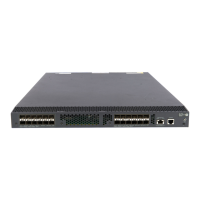none: Does not perform authentication.
radius-scheme radius-scheme-name: Specifies a RADIUS scheme by its name, a case-insensitive string of
1 to 32 characters.
Usage guidelines
You can specify multiple authentication methods, one primary and multiple backup methods. When the
primary method is invalid, the device attempts to use the backup methods in sequence. For example, the
authentication lan-access radius-scheme radius-scheme-name local none command specifies a primary
RADIUS authentication method and two backup authentication methods, local authentication and no
authentication. With this command, the device performs RADIUS authentication by default, performs
local authentication when the RADIUS server is invalid, and does not perform authentication when both
of the previous methods are invalid.
Examples
# Configure ISP domain test to use local authentication for LAN users.
<Sysname> system-view
[Sysname] domain test
[Sysname-isp-test] authentication lan-access local
# Configure ISP domain test to use RADIUS authentication scheme rd for LAN users and use local
authentication as the backup.
<Sysname> system-view
[Sysname] domain test
[Sysname-isp-test] authentication lan-access radius-scheme rd local
Related commands
• authentication default
• local-user
• radius scheme
authentication login
Use authentication login to specify the authentication method for login users.
Use undo authentication login to restore the default.
Syntax
In non-FIPS mode:
authentication login { hwtacacs-scheme hwtacacs-scheme-name [ radius-scheme radius-scheme-name ]
[ local ] [ none ] | ldap-scheme ldap-scheme-name [ local ] [ none ] | local [ none ] | none |
radius-scheme radius-scheme-name [ hwtacacs-scheme hwtacacs-scheme-name ] [ local ] [ none ] }
undo authentication login
In FIPS mode:
9

